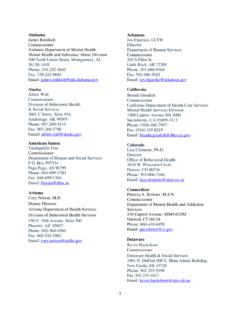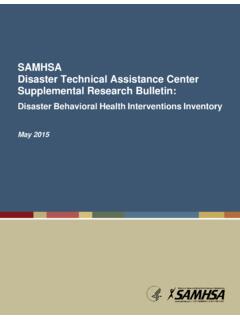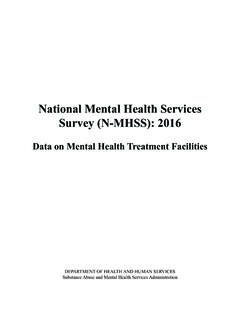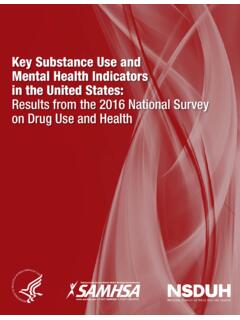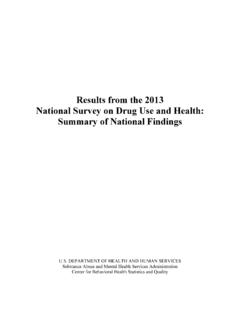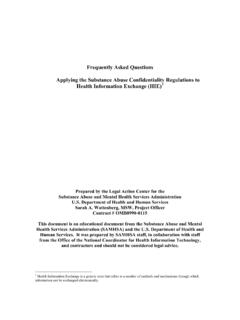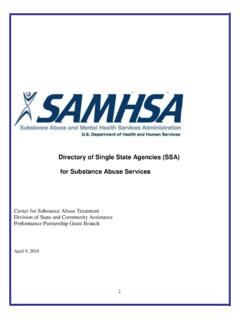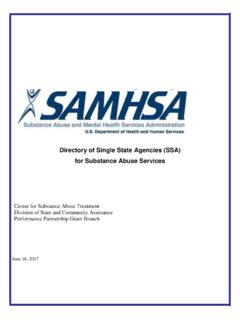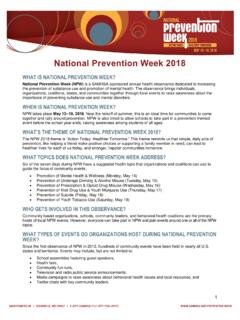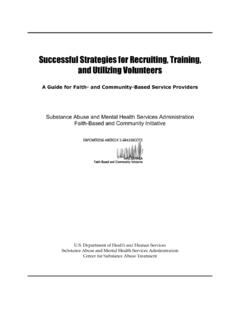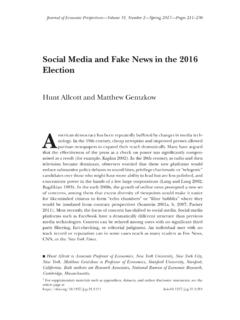Transcription of Table of Contents - SAMHSA
1 Table of Contents Introduction .. 1 ROSC in the New health Care Environment .. 2 History of ROSC .. 6 Recovery Support services (RSS) .. 7 Role of Recovery Management .. 10 What Is Happening Around the Country? .. 12 California .. 12 North Carolina .. 12 Vermont .. 13 Planning and Implementation Steps .. 15 Additional ROSC Resources .. 25 Additional health Care Reform Resources .. 25 Summary .. 27 1 Recovery-Oriented Systems of Care (ROSC) Resource Guide Working Draft Introduction Are you looking for resources on resiliency and recovery-oriented systems of care (ROSC)? Further, have you been reading the headlines concerning national health care reform and wondering how it will impact programs and services within a ROSC?
2 This guide, which contains information from the substance abuse and mental health services administration ( SAMHSA ), and your colleagues around the country, will assist you with answers to these questions. State and local policy makers responsible for substance use programming, as well as providers of treatment and recovery support services , can look to this guide for information to enhance prevention, treatment, and recovery services as the changes in health care evolve in their communities. The purpose of this resource guide is to share an overview of ROSC and illustrate how these systems are an integral part of the new health care environment.
3 This guide will align the tenets of health care reform to the benefits, framework, and history of ROSC, and the steps for planning and implementing ROSC. Following each section of the guide s narrative, you will find websites to direct you to specific resources that will assist you in conceptualizing and developing ROSC. The resources in this guide include research studies, white papers, conference presentations, manuals, practice guides, check lists, regulations and a number of other documents that have been prepared in response to the need for systems reform. The establishment of ROSC is a relatively new concept in the substance use disorder field.
4 The structure of ROSC will likely evolve as these systems mature and are evaluated. However, as States and communities are creating and implementing ROSC, they can learn from one another. At the same time that they are developing ROSC, they must also consider the changes that are occurring as a result of health care reform. Some policy makers and providers have begun to assess their community strengths and needs in this regard and formulate ROSC plans that are compatible with the tenets of national health care reform. We hope this resource guide will assist with that process. One of the most important elements of national health care reform is the expansion of coverage for those with substance use and mental health disorders.
5 The law also requires parity or that group health insurance plans that provide coverage for mental health and substance use disorders be equal to coverage provided for other medical and surgical benefits. These sweeping changes form the foundation for the new health care environment. Ingrained in health care reform is a public health model that supports ROSC through its vision of prevention, screening and early intervention, treatment, and recovery, integrated with primary health care. Complex developments that include new benefit packages and financing strategies, greater use of technology, promotion of evidence-based practices, and the very important linkage with primary care all present opportunities and challenges that will be addressed in months and years to come.
6 For this reason, this resource guide will be a very fluid product. As information on new initiatives and findings becomes available, it will be incorporated into the resource guide to further illuminate this new environment. The goal of this guide is to arm you with sufficient information to leverage resources that will create the most favorable outcomes for individuals, families and communities. 2 Recovery-Oriented Systems of Care (ROSC) Resource Guide Working Draft ROSC in the New health Care Environment A ROSC is a coordinated network of community-based services and supports that is person-centered and builds on the strengths and resiliencies of individuals, families, and communities to achieve abstinence and improved health , wellness, and quality of life for those with or at risk of alcohol and drug problems.
7 The central focus of a ROSC is to create an infrastructure or system of care with the resources to effectively address the full range of substance use problems within communities. The specialty substance use disorder field provides the full continuum of care (prevention, early intervention, treatment, continuing care and recovery) in partnership with other disciplines, such as mental health and primary care, in a ROSC. A ROSC encompasses a menu of individualized, person-centered, and strength-based services within a self-defined network. By design, a ROSC provides individuals and families with more options with which to make informed decisions regarding their care.
8 services are designed to be accessible, welcoming, and easy to navigate. A fundamental value of a ROSC is the involvement of people in recovery, their families, and the community to continually improve access to and quality of services . The Table below further illustrates the range of recovery-oriented services that may be offered in a ROSC. Examples of Recovery-Oriented Activities Prevention Intervention Treatment Post-Treatment Examples of Recovery-Oriented Activities Early screening before onset Collaborate with other systems, , Child welfare, VA. Stigma reduction activities Refer to intervention treatment services Screening Early intervention Pre-treatment Recovery support services Outreach services Menu of treatment services Recovery Support services Alternative services and therapies Prevention for families and siblings of individuals in treatment Continuing care Recovery support services Check-ups Self-monitoring Traditionally, recovery-oriented services have been viewed as long-term recovery related activities that occur after a formal substance use treatment episode.
9 However, recovery-oriented activities and approaches are also part of the full continuum of care available to persons within a ROSC. substance use problems are preventable, but left untreated can progress into more serious conditions and can become chronic. A ROSC provides a network of services and supports to address the full spectrum of substance use problems, from harmful use to chronic conditions. Through education, communities are strengthened by recovery-oriented activities that can prevent inappropriate substance use before it occurs. Education also raises awareness about the disease, 3 Recovery-Oriented Systems of Care (ROSC) Resource Guide Working Draft dispels myths that foster stigma and discrimination, and provides early intervention for those at risk of developing substance use conditions.
10 A ROSC supports the premise that there are many pathways to recovery. Recovery-oriented activities include providing a menu of traditional treatment services and alternative therapies, including peer recovery coaching, acupuncture, meditation, and music and art therapy. Recovery support services , including employment assistance, child care, care management and housing support, may enhance the engagement of individuals and their families in achieving and sustaining recovery. The following websites will provide you with background material to assist in understanding recovery-oriented activities and approaches: Guiding Principles and Elements of Recovery-Oriented Systems: What do we know from the research?
